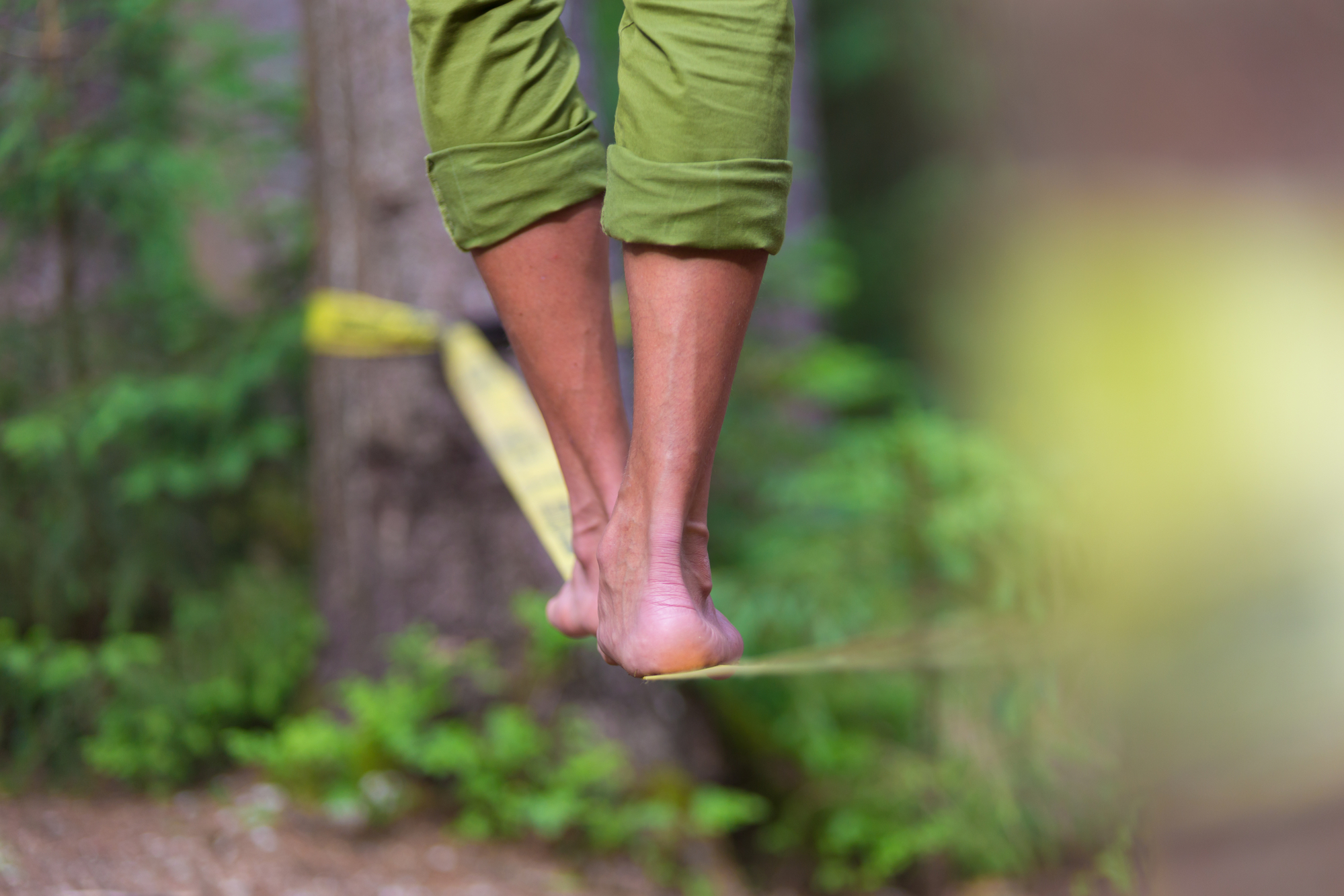Slacklining is a fun and challenging sport that can be enjoyed by people of all ages. It is a great way to improve balance and coordination, and it can also be quite addictive!
As it turns out, slacklining is a lot harder than it looks. This challenging and fun sport has been growing in popularity in recent years, and for a good reason.
If you want to know more about this unique and exciting activity, read on to find out everything you need to know!
So is Slacklining Really Hard?

The truth is, slacklining is not for the faint of heart. This challenging sport requires a lot of balance and coordination, and it can be quite dangerous if you're not careful.
It's important to always practice safety first when slacklining and never attempt to do anything beyond your skill level.
With that said, however, slacklining can be an incredibly fun and rewarding experience.
No matter your skill level, there's a type of slacklining perfect for you. From beginners to experts, there's something for everyone to enjoy.
Even kids can have an excellent time slacklining, as long as they're supervised by an adult.
However, if you're looking for a challenge, you'll definitely want to try your hand at tricklining. This more advanced form of slacklining involves performing tricks and stunts on the line.
Whether you're looking for a new way to challenge yourself physically or just looking for a fun and unique activity to enjoy with friends, slacklining is definitely worth checking out!
Tips for Getting Started in Slacklining

Now that you know more about slacklining, you're probably wondering how to get started.
If you're interested in giving slacklining a try, you should keep a few things in mind.
1. Stretch before practice.
Slacklining requires a lot of balance and coordination, and it's important to stretch before attempting any tricks or stunts.
Stretching will help you avoid injury and make it easier to maintain your balance.
Make sure to warm up before stretching and listen to your body. If something feels uncomfortable, stop.
Here are a few stretches that are perfect for slacklining:
Hamstring stretch:
- Lie on your back with one leg straight and the other bent.
- Place a strap or towel around your foot and slowly straighten your leg until you feel a stretch in your hamstring.
- Hold for 30 seconds and repeat with the other leg.
Calf stretch:
- Stand with your feet hip-width apart and place your hands on a wall.
- Lean forward and press your heels into the ground as you stretch your calves.
- Hold for 30 seconds and repeat.
Hip flexor stretch:
- Kneel on one knee with the other foot planted in front of you. Keep your back straight and lean forward until you feel a stretch in your hip flexor.
- Hold for 30 seconds and repeat with the other leg.
Shoulder opener:
- Stand with your feet shoulder-width apart and interlace your fingers behind your back.
- Raise your arms up as high as possible and hold for 30 seconds.
2. Use your hands for balance
When you first start slacklining, it's essential to use your hands for balance.
However, as you get more comfortable, you can try letting go and see how long you can stay on the line without using your hands.
Remember to always practice safety first and never attempt anything beyond your skill level.
Start by walking across the line slowly and carefully. As you get more comfortable, you can try picking up the pace.
Eventually, you will be able to run and even jump on the line!
Just remember to take your time and have fun. Slacklining is all about challenging yourself and enjoying the process.
3. Put some weight on your leg on the line
When you first start slacklining, remember to keep your weight evenly distributed between your legs.
How do you get on the slackline? The leg on the line should support 70% of your body weight. The other 30% should be on your free leg.
As you get more comfortable, you can shift your weight and experiment with different positions.
Step on the line, then close your eyes and concentrate on a point in front of you. You may not be able to master it on the first or second try, but eventually, you can get it!
4. Always be aware of your surroundings
Slacklining can be a lot of fun, but it's important to always be aware of your surroundings.
Make sure there is nothing in the way that could trip you up, and always be aware of who or what is behind you.
It's also a good idea to have a spotter nearby if you lose your balance.
Make sure you're not slacklining near any power lines or other hazards.
Also, be sure to keep an eye on the weather conditions. If it starts to rain or thunderstorm, it's best to pack up and head indoors.
Safety should always be your number one priority when it comes to slacklining.
5. Don't be afraid to fall
One of the most important things to remember when learning to slackline is not to be afraid of falling.
Falling is part of the process, and you'll never get better if you're afraid to take a few spills. Just be sure to fall backward and land on your backside.
This will help cushion the impact and prevent any serious injuries.
The key is to get back up and try again. If you train your mind to think of falling as part of the process, it will be less scary.
Never give up, and eventually, you'll be able to stay on the line for as long as you want!
6. Make sure the lines are tight
Another important thing to remember is to make sure the lines are tight.
If the line is too loose, it will be harder to balance. If it's too tight, however, it could snap.
The best way to achieve the perfect tension is to use a ratchet system. This will allow you to adjust the tension quickly and efficiently to get it right.
Once you've got the perfect tension, double-check all the knots and connections to make sure they're secure.
You may start walking on loose slacklines once you've mastered the basics. However, loose lines are best used for bouncing or surfing across the line.
Just be sure to have significant slackline experience before trying these tricks!
7. Focus on a point
When you're first starting out, focus on a point in front of you.
This will help you maintain your balance and avoid getting dizzy. As you get more comfortable, you can look around and take in the scenery.
Keep your focus and concentration, or you may find yourself taking a tumble.
Don't keep looking down. Have faith in your feet.
Choose something neutral as a point of focus. The objective is to concentrate and keep your attention on the game.
8. Practice, practice, practice!
The only way to get better at slacklining is to practice, practice, practice!
Start by walking back and forth on the line. Once you've got that down, you can experiment with different positions and tricks.
The more you practice, the more comfortable you'll become. And eventually, you'll be able to walk across the line with your eyes closed!
Remember, there is no shame in falling. Everyone falls at first. The key is to keep getting back up and trying again.
Conclusion

So, is slacklining hard? It can be challenging at first, but it's definitely not impossible.
With a little bit of practice, anyone can learn how to slackline. Just be sure to start slowly, focus on your balance, and don't be afraid to fall.
Before you know it, you'll be crossing the line like a pro!
Have fun and stay safe!









